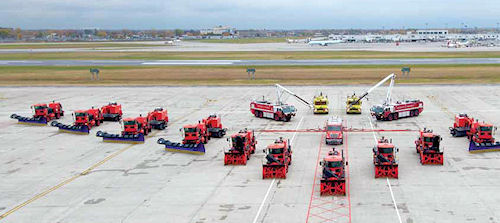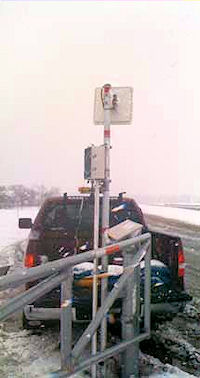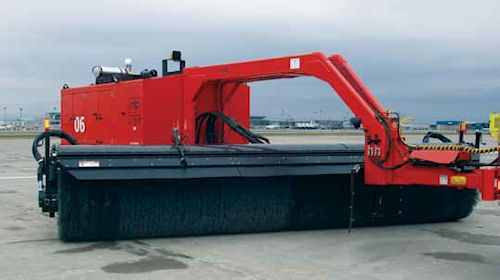Enhanced Fleet Speeds Snow Removal & Provides Volume Accounting at Montreal's Trudeau Int'l

Just like their customers, northern airports dread delays caused by snow events. To speed snow removal at Montreal-Pierre Elliot Trudeau International Airport, airport authority Aéroports de Montréal (ADM) replaced nearly all of its fleet of snow removal vehicles and attachments for the 2008/2009 season.
|
Facts & Figures Project: Snow Removal Fleet Enhancements Location: Montreal-Pierre Elliot Trudeau International Airport Owner: Aéroports de Montréal Prime Integrated System Contractor/Dealer: Team Eagle Snow Removal Vehicles: Oshkosh Snow Plows: Wausau Runway Brooms: M-B Companies Liquid De-icer: Tyler Ice Control RFID Equipment: TransCore Wireless Networking Equipment: Vecima Networks Benefits: Faster snow clearing, automated accounting of snow taken to dump |
"The equipment and new snow removal techniques give [air navigation services provider] NAV CANADA more time to land aircraft, reduce the frequency of ground stops and save aircraft fuel," explains Desrosiers.
Eagle Airfield, the snow removal and ice control division of Team Eagle Ltd., supplied the following equipment:
• 13 Oshkosh H-Series vehicles
• five Oshkosh blowers, each with a capacity of 5,000 tons-per-hour
• eight 24-foot-wide Wausau front plows
• eight 22-foot-wide tow-behind brooms
manufactured by M-B Companies
• one Tyler Ice liquid deicer spreader that can carry 3,170 gallons of potassium acetate and cover a 100-foot-wide swath
"Everything about the vehicles, such as visibility and operator comfort, is nicer than what we used to have," Desrosiers says.
Eagle also provided classroom/practical training and service support for the equipment.
For added safety, the two lead snow removal vehicles are equipped with EagleEye Drivers Enhanced Vision System, a software package from Eagle Integrated Solutions. The enhancement gives equipment drivers a bird's-eye view of the airfield and features graphics they can zoom in and out. The system can also be  programmed with geo-fencing to prevent incursions into particular zones. For example, a virtual border can be created to form a 10-foot restricted zone around fire hydrants, explains Sylvain Marchand, ADM's section chief of airfield maintenance. If drivers cross into the zone by driving "through" a geo-fence, they receive a vocal warning from the system.
programmed with geo-fencing to prevent incursions into particular zones. For example, a virtual border can be created to form a 10-foot restricted zone around fire hydrants, explains Sylvain Marchand, ADM's section chief of airfield maintenance. If drivers cross into the zone by driving "through" a geo-fence, they receive a vocal warning from the system.
Paul Cudmore, general manager of Team Eagle, considers Trudeau International one of the most progressive airports in North America. "Other airports around the world have benefited from their innovative way of looking at airfield challenges," says Cudmore.
Montreal-Trudeau's enhanced fleet shaved its snow clearing time by 20 minutes.
Keeping Tabs

The fleet at Trudeau International is responsible for clearing 475 acres worth of apron, runways and taxiways. To clear the area, the fleet must collectively drive 186 miles. With an average annual snowfall of 87 inches and about 57 snow events per winter, the airport has about 784,800 cubic yards of snow (10,000 truckloads) to remove each year.
Traditionally, ADM posted an employee at the snow dump to manually count the trucks entering and estimate the volume of snow they delivered. The contract with the snow dump is based on a delivery cap of 7,848 cubic yards per hour, but the dump contractor had estimated that twice that was being delivered. To liberate the employee for other duties and to get a more accurate measure of the snow being dumped, Eagle developed an automated Radio Frequency Identification (RFID) system to count the number of dump truck loads and tally the volume of snow being hauled to the dump.
Eagle installed the system in March, with technical support and labor from ADM's electrical department. The new system includes active RFID tags with a 50-foot range and an RFID reader purchased from TransCore. An existing wireless networking system Eagle had installed earlier for vehicle tracking provides data transmission.
"Active tags were required due to the lack of proximity of the reader to the target vehicle," explains Rick Thibodeau, manager of production and planning for Eagle Integrated Solutions. "The high speed of vehicles makes passive systems unreliable." 
Permanent tags were installed on the front bumpers of the airport's tractor-trailers and inside the front windshields of smaller trucks owned by its main snow removal contractor. Subcontractors use portable tags inside their front windshields.
Each tag has a unique identification code that is correlated with a specific vehicle and is programmed with a load rating that reflects the different size dump boxes: 39, 81 and 131 cubic yards.
The reader is positioned at the exit of the snow dump. Thibodeau
|
This RFID reader counts trucks leaving the snow dump area. |
The exit not only made a convenient choke point; it also allowed Eagle to point the reader away from the airport, which would have been a source of interference. Despite this precaution, ADM and Eagle still tussled with a vexing problem for two months. "We had, as it turned out, an interference problem from another RFID system antenna in the parking lot," Marchand relates.
Thibodeau continues his explanation: "The reader has to filter multiple reads of the tag during one outbound pass for all possible positions of tags in different vehicles. We had to ensure that multiple reads would count as only one pass in a span of five minutes after a truck passes the reader."
Even with the new RFID system, one manual task remains. Because the software cannot determine if loads are full or empty, the contractor must report to ADM how many empty runs are made.
|
Runway Broom from M-B Companies |
|
Lead truck drivers use the EagleEye Drivers Enhanced Vision System to avoid incursions and obstacles. |
The ability to have such data at its disposal will allow ADM to accurately determine the volume of snow being delivered to the snow dump. "We estimate that in a snowstorm, the volume delivered is about 5,232 cubic yards an hour," Desrosiers says. "And this year, we will have the statistics."
FREE Whitepaper
PAVIX: Proven Winner for All Airport Concrete Infrastructure
International Chem-Crete Corporation (ICC) manufactures and sells PAVIX, a unique line of crystalline waterproofing products that penetrate into the surface of cured concrete to fill and seal pores and capillary voids, creating a long lasting protective zone within the concrete substrate.
Once concrete is treated, water is prevented from penetrating through this protective zone and causing associated damage, such as freeze-thaw cracking, reinforcing steel corrosion, chloride ion penetration, and ASR related cracking.
This white paper discusses how the PAVIX CCC100 technology works and its applications.











